PPC
Five Ways to Use AI to Improve Copywriting and PPC Performance

As AI begins to shape the landscape of digital marketing, content managers, copywriters, and digital marketers are starting to explore its potential applications for copywriting.
It’s been predicted that AI would take over a lot of the grunt work associated with creating and managing content – from doing basic research to developing detailed editorial calendars.
Others believe that machine learning can complement human skills and help writers produce better content. So far, artificial intelligence hasn’t quite taken over copywriting as a whole, but it is nonetheless having a huge impact on it in significant ways.
It’s not just copywriting that has seen the beneficial effects of AI. From AI-powered robo advisors that help improve return rates on different investments to impressive video filters that make social media more fun, pretty much all industries are finding ways to use this evolving technology.
Considering this trend is showing no sign of stopping, digital marketers need to understand how AI is impacting copywriting and what kind of opportunities this technology creates for their businesses.
Let’s explore four ways AI is changing the field of copywriting and discuss how marketers can take advantage of these changes to improve PPC performance.
A Short Introduction to AI
AI is short for artificial intelligence, a field of computer science and engineering focused on creating intelligent machines that work and react like humans. In other words, AI involves making computers smarter – something they’re already very good at, thanks to their huge data processing power and ability to learn from experience rapidly.
Put simply, AI works by using algorithms to analyze data so that computers can understand it better. This data might be in the form of text, images, or videos. Once the computer has understood the data, it can then use this information to carry out certain tasks – such as recognizing objects in pictures or understanding natural language.
Most AI algorithms work much in the same way. They start by learning from a data set we humans provide (a process known as “training”). The computer runs a series of calculations during training to develop an equation that relates all the data it was trained on. Then the AI uses this knowledge to make predictions about new data (known as “inference”).
In other words, an “AI” is no more than a piece of software that basically wrote itself to perform a particular task (like copywriting) after training on a given data set and following certain guidelines given by the programmer. Since no two data sets (collections of pictures, videos, or text) are likely the same, no two AI software are ever the same either, even if both were developed by the same publisher.
Companies with large volumes of data on their users can leverage AI for different purposes, from generating sales to improving customer satisfaction. For example, credit card companies and other banking and fintech businesses have been using AI to provide users with insight into their own spending habits, helping them budget more effectively.
Other industries use AI to detect possible scams and frauds based on behavioral patterns.
AI in Copywriting
Copywriting is one of the fields where AI has made a big impact. A copywriting AI is a writing assistant that can help you with the task of creating content. Copywriting AIs are usually powered by natural language processing (NLP), a branch of AI that deals with understanding and generating human language.
There are different types of copywriting AIs trained for different purposes. In general terms, they can be broadly classified into two groups: content generation and editing software.
Content Generation
A content generation AI is an AI that writes original content based on input from the user. These AIs are usually trained on a large data set of human-written text, such as news articles or blog posts. And when I say a large data set, I mean large. For example, Jasper (previously known as Jarvis) is one of the best AI copywriting tools trained on a data set of roughly ten percent of the internet’s written content.
Content generation AIs work by understanding the user’s input (usually in the form of keywords, although the more sophisticated software clearly understands instructions) and then generating new text relevant to the input. The generated text is usually not perfect, but it gives the user a good starting point that can be edited and improved upon.
Editing Software
Editing software, on the other hand, is designed to help users improve their writing by checking for grammatical errors and offering suggestions on how to rephrase certain sentences. These AIs are usually trained on a data set of well-written text, such as books or articles from high-quality websites. Some popular editing software includes Grammarly and ProWritingAid.
How AI is Used in Copywriting and Digital Marketing
Automated content generation tools have taken the digital marketing landscape by storm. In particular, they have been a godsend for content marketers and SEOs who are always on the lookout for new and original content at the lowest cost possible.
The rise of AI has also led to new tools and strategies for copywriting and digital marketing. Here are some of the ways AI is being used in these fields:
#1.) To Enhance Copywriting Productivity
Copywriting AIs can help content marketers and copywriters be more productive by taking on some of the grunt work involved in creating content. For example, content managers can use a copywriting AI to generate ideas for new articles or blog posts based on a set of keywords provided by the user.
The AI can then produce a list of potential topics that the user can choose from. Similarly, once a copywriter chooses a topic to write about, they can then use the same AI to generate an outline for the blog post if that’s what they plan to write.
You could keep breaking each section into subsections to go as deep into a topic as possible. Finally, once you’re satisfied with the outline, you can ask the AI to write out the content under each subheading.
By fact-checking here and there and ensuring that everything ties into a seamless narrative, you could have a high-quality, 2,000-word blog post fully written and proofread in under two hours.
Talk about productivity!
#2.) Editing for Spelling, Grammar, and Style
Editing AIs can help copywriters improve the quality of their writing by checking for spelling and grammar errors, as well as offering suggestions on how to rephrase certain sentences.
For example, suppose you’re writing an ebook about the benefits of nano-influencer marketing, and you want to make sure that it’s error-free. You can run your document through an AI editing software such as Grammarly or ProWritingAid, and it will highlight any errors in your text. The software will also offer suggestions on fixing the errors, making your message clearer, and adapting it to a particular writing style.
In addition to correcting errors, you might also find that your text sounds more polished after running it through AI editing software. This is because this software is often tuned to identify style issues such as overuse of certain words or phrases, sentence length variation, and so on.
Making these style corrections lets you ensure that your writing sounds natural and easy to read, which is essential.
#3.) To Improve Conversions
Copywriting AIs go far beyond writing blog posts and correcting your grammar. Since they’re trained on massive amounts of online written data, and much of that data is marketing copy, they’ve become increasingly efficient at producing highly-converting copy based on different frameworks.
This means it will only take you minutes to craft an ad copy based on the Problem-Agitate-Solution (PAS) framework or the classic Attention, Interest, Desire, Action (AIDA) framework. Or you could go for the Before-After-Bridge framework and see which one works best for your audience.
This is particularly appealing to PPC marketers who need to write the most eye-catching and compelling copy to attract the attention of short-attention-spanned internet users.
But, how do you know which framework works best for your audience and leads to more conversions?
The answer is A/B testing, an experimental technique to compare two versions of a web page to see which one performs better. A/B testing has long been the gold standard for optimizing conversion rates, but it can be time-consuming and expensive, especially for small businesses and startups. However, copywriting AIs make this extremely easy since writing out entire ads in different frameworks, styles, and tones only takes a couple of minutes.
Also, there are now AIs that specialize in conversion rate optimization (CRO). These work by constantly testing different versions of website copy and design elements to see which ones result in the highest conversion rates.
These tools essentially automate A/B testing to make it cheaper, faster, and more effective. A good example of this is Unbounce Smart Traffic, which was the first AI-powered CRO tool to hit the market. Many more followed suit.
#4.) Generating Targeted Content
Digital marketing is all about creating content that resonates with your target audience. You can use copywriting AIs to generate targeted content for your specific niche if you know your audience well. You can do this simply by instructing the AI to write a copy for that particular audience.
But that’s not even half of it. Other variations of these software tools, such as evolv.ai, tweak and adapt the ad and landing page content dynamically for every user based on a set of predefined criteria such as location, keyword use, and other factors. This is micro-segmentation marketing on steroids, and it’s only possible thanks to the way AI understands where each internet user is coming from.
#5.) AI for SEO
We already discussed the power of AI for improving copywriting productivity by helping writers come up with new topic ideas based on given keywords. But how do you know which keywords to target?
This is where AI comes in handy again. You can use AI tools for contextual targeting purposes: they work perfectly with keyword research and help to develop a list of relevant keywords that you can then target with your content.
In addition, copywriting AIs are also getting better at understanding SEO best practices and can help you tweak your copy accordingly to make it more search engine friendly. Surfer is one of the most popular SEO optimization tools out there, and, guess what? It’s also an AI.
The Bottom Line
As digital marketing evolves, copywriters and content managers must embrace new technologies like AI to stay ahead of the curve. In particular, AI can help content managers and digital marketers in every stage of content production and delivery.
From coming up with relevant keywords to target and using them to come up with topic ideas and relevant subtopics, to actually crafting the content itself.
Additionally, You can use AI for several other important tasks, such as SEO optimization and improving conversions.
By understanding how AI works and using its capabilities to your advantage, you can create more effective PPC campaigns that connect with your target audience and improve your PPC performance. If you’re not using AI for your digital marketing efforts right now, you’re already falling way behind.
PPC
Does Ad Strength Matter in Google Ads?

Ad Strength is one of those metrics that ebbs and flows in importance. Right now, there’s been an uptick in conversations Google’s Ad Strength metric. Those discussions were prompted by a recent press release from Google around some new features coming to the platform. These updates were mostly centered on updates coming to Performance Max capabilities using AI for text and imagery.
So we felt like now was a good time to dive into Google Ad Strength and discuss whether or not it actually matters—and how to improve it if it does.
Contents
What is Ad Strength?
Before we get into whether or not you should pay attention to Ad Strength, let’s talk about what it is.
Essentially, Ad Strength is meant to help advertisers develop strong ads that are more likely to perform well based on Google’s data, but is only used as an indicator, not an actual ranking.
In that way, it’s very similar to Quality Score or Optimization Score. Both are meant to help advertisers develop strong keyword lists and ad accounts, but aren’t actual dictators of how the account will do.
🛑 Worried you’re wasting spend in Google Ads? Find out with a free, instant audit >> Google Ads Performance Grader
How does Ad Strength impact Google Ads?
Does not having the necessary quantity and variety of assets negatively impact your ad performance?
If you look at the definition of Ad Strength…

…it almost seems like it would have a negative impact. Specifically, the last two sentences calling out maximizing performance and the effectiveness of your ads.
But countless advertisers have had different experiences, many of them claiming that their Poor ads actually outperformed the Excellent or Good ads in their accounts.
Additionally, you may notice that ads with a Poor or Average Ad Strength don’t have as many impressions as those with Good or Excellent ratings.
So, does a low Ad Strength mean your ads are going to have their impressions throttled?
The short answer is no to both:
- Ad Strength will not impact the performance of your ads on Google.
- A low Ad Strength will not prevent your ads from showing on Google.
But here’s the thing…both of those things COULD happen IF you have low Ad Strength.
If your Ad Strength is low, you could see worse performance for those ads. Your ads also might not win many auctions if they have Poor Ad Strength.
Google has emphasized many times that Ad Strength is only an indication of how well your ad is constructed based on their internal best practices.
After some other articles were written, Ginny Marvin, Google’s Ad Liaison, responded with this message:


⚡️ Is your Google Ads account set up for success? Download now >> The Last Guide to Google Ads Account Structure You’ll Ever Need
Recent updates that impact Ad Strength
As I mentioned, Google recently released some updates to its Google Ads platform that have put a spotlight on Ad Strength. You can read that article here and hear about how we think these changes lean into Google’s two main focuses for Performance Max updates here.
But one paragraph caught the eye of many advertisers and really started this whole Ad Strength discussion:


Google says that moving forward, the quantity and variety of assets will now play a larger role in your Ad Strength scores for your creatives. Basically, “since we’re making it easier for you to have these additional assets and variety, we’re going to start holding you accountable to these standards.”
For the most part, advertisers don’t have an issue with this…but with the actual impact of Ad Strength as a whole.
Should you pay attention to Ad Strength?
(I’ll start this section by saying that I’m writing this from my own personal experience as well as those that I’ve heard from others. I’d love to hear from anyone who disagrees with my approach or would tweak it based on your own experiences. The more points of view, the better.)
Now that you’re caught up on the recent discussions in the industry and I have my disclaimer out of the way, let’s focus on what actually matters for your day-to-day:
Should you pay attention to Ad Strength or not? If so, how should you pay attention to it?
My opinion: sometimes.
Your goal as a marketer should always be to create ads that are as relevant and meaningful as possible to your clients and their respective customers. If you’re doing this well, you’re likely going to hit most of the benchmarks for a high Ad Strength right out of the gate. And that applies for all ad formats.
💡 Want to learn more about search engine marketing on Google? Get the free guide >> PPC 101: Complete Guide to Google Ads
How can you improve Ad Strength?
Here are a few high-level suggestions for best practices with ads:
- Create compelling messaging that highlights the business’s strengths.
- Answer the customer’s query or relate the ads to the content they’re viewing (if possible), i.e. include keywords or something relevant to your targeting.
- Test different variants of your messaging. You never know what will work best.
- Leverage all the bells and whistles you can including images, videos, logos, locations, ad assets, etc.
While those have been many of the ad copywriting best practices (in my mind) for a long time, it’s not as obvious that they’re tied to Ad Strength as well.
Whether it’s the Ad Strength indicators for Responsive Search Ads:


Or the different ratings you can achieve with Performance Max:
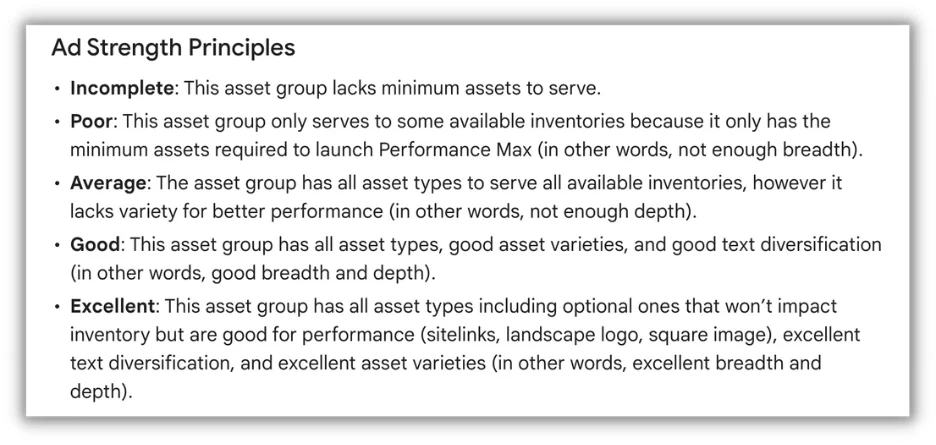

Those best practices get you most of the way there. Your job is to then monitor your ad performance and determine if you need to make adjustments.
If you’re seeing good performance from your ads and you’re happy with everything, you might not care what your Ad Strength is.
If you’re not getting the results you need, maybe look at the Ad Strength Improvements column and see what guidance Google gives.
You can even take it one step further. Click to edit the ad and see what suggestions Google has for you on each of the suggested areas for improvement. I have it blurred out below, but there are a handful of new headlines suggested for this ad variant that Google thinks could be better. Maybe they work, maybe they don’t, but I at least have some new ideas that I didn’t have to think of on my own.


For Performance Max, you can now create all sorts of new assets directly in the editor without much work. There’s almost no excuse for not having more ad assets to help you level up your score.
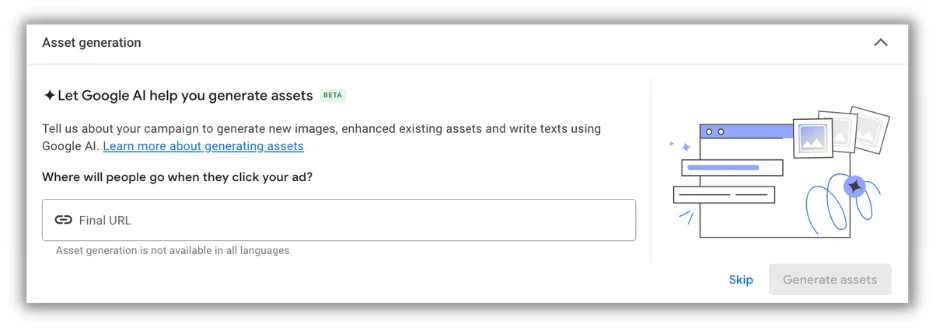

Don’t make Ad Strength your campaign’s weakness
As a reminder to close this out, don’t optimize to Ad Strength just because Google promotes it. Don’t forget, Ad Strength is not your KPI. Focus on your business KPIs and use Ad Strength as you need to maybe make some improvements.
Need help with your Google Ads campaigns? Find out how we can help.
PPC
Standard Performance Max vs Performance Max for Retail

Google has recently changed the name of standard Performance Max to Performance Max for online sales or lead generation and Performance Max Retail to Performance Max for online sales with a product feed.
A rose by any other name might still smell as sweet. But even as they’ve stayed the same species how do these two roses within Google Ads’ garden differ?
Performance Max for retail is an ad campaign type that builds on your Google shopping campaign, while bringing in the most valuable features of Performance Max. This enables you to leverage the account inventory from within your Merchant Center accounts with all the clever automatic weapons at Performance Max’s disposal.
Before we go into more detail, how about a brief recap of what Performance Max campaigns actually are?
What is Performance Max?
Performance Max is an all-encompassing campaign format that puts your conversion goals above all else.
This should not be mistaken for one-size fits all. Rather it offers a structure that allows you to set the CPA or ROAS aims of the campaign, provide the assets, audience signals and data feeds, and basically let Google play mix and match. That means that bidding, budget optimisation, audiences, creatives, attribution and – most significantly – on which of Google’s properties you appear, are all decided by AI. As well as search (naturally) you could find yourself showing ads on YouTube, Display, Discover, Gmail and Google Maps. All within the single campaign.
If that sounds a bit black box-y, it needn’t be. It’s true that you are obliged, to a reasonable extent, to trust in the tool. Also to be more flexible with what it comes up with than you might initially feel comfortable. A campaign manager wants to be campaign managing, after all.
Performance Max campaigns will, however, tell you everything about what within your campaigns is and isn’t working. You are then free you to eliminate those that aren’t effective, while identifying new conversion streams that you might not previously have conceived.
What are the benefits of Performance Max Retail over standard smart shopping campaigns?
You will have spotted that among the Google properties listed in the introduction to Performance Max, Google Shopping was not among them (except indirectly, linked to search.) That’s because in order to run them, you will need a Merchant Centre Account (which many advertisers either simply don’t, or isn’t applicable to them) linked to your Pmax campaign.
But Google shopping ads are as much part of the advertising landscape as their text brethren. They will benefit just as much from a Pmax boost. If you’re a retailer using Google Shopping campaigns, you’re going to want to at least try Performance Max Retail.
The advantages of Pmax Retail over shopping include:
- Language targeting based on Merchant Center feed or campaign criteria
- Final URL expansion – allowing you to replace your Final URL with a more relevant landing page based on the user’s search query and intent, and to customize a dynamic ad headline that matches your landing page content
- All stores are targeted when the Store Visit goal is selected
- The ability to set conversion goals on a per-customer or per-campaign basis
For want of a better way of putting it, Performance Max Retail is Google Shopping on steroids.
Just as with Performance Max the conversion is the thing. Unlike in a standard Pmax campaign, you’re providing an even more valuable asset source, by way of real time inventory and product data, to inform the ad creation and targeting. Compared to your normal Shopping campaign, you’re going searching for customers and converting them, rather than waiting around for them to come to you.
If you already have a Merchant center account it’s very simple to add it to your Pmax campaign and make it Pmax retail. All you have to do is change the settings within Performance max to tell it to be retail, apply your Merchant center ID and finally provide a Feed Label. The Feed Label can be either a product feed, which means the campaign will only target the products in that feed, or a two-letter country code, which will allow you to target all products from that country.
Google Ads will then go to work, using everything you’ve given it by way of assets to automatically create and serve a wide range of ad formats to all sorts of audiences, in all kinds of spaces.
Just as with standard shopping ads, if a product is no longer available and drops out of your feed, it will not not be used to create an ad.
The amount of latitude you give Performance Max Retail will be up to you – just as with Performance Max (and in a similar way with standard Shopping) you have control over the limits – but if you’ve ever seen anything resembling Google Shopping ads popping up in surprising places, chances are they’ve been created using Performance Max Retail.
Go wild in the aisles and see what Performance Max Retail can do for you.
PPC
Marketing Funnel: Stages, Strategies, & How It Works

While everyone has different marketing strategies, there is one thing that every marketing plan should have: the marketing funnel.
Understanding your marketing funnel is the key to identifying the best content and strategies for moving customers along in their journey.
In this post, I will break down everything you need to know about the marketing funnel, including what it represents for your business, why you need one, and how to use it to maximize your success.
Contents
What is the marketing funnel?
The marketing funnel represents a consumer’s journey from being unaware that you exist to becoming a customer. It’s often broken up into four different stages, but the number of stages and names of those stages vary depending on who you talk to. One of the most widely accepted sets of stages is as follows:
- Awareness
- Interest
- Desire
- Action
We’ll talk more about each of these phases later in this post.
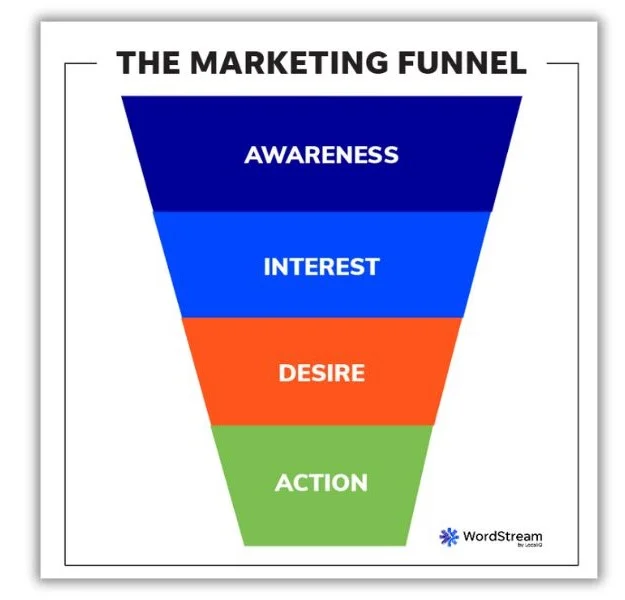
The marketing funnel is shaped like a funnel because you naturally get drop-off along the way. Not everyone who becomes aware of your business, product, or service will complete the journey to becoming a customer. The idea is to maximize that number, of course.
🛑 Want to improve every stage of your marketing funnel? Download 130+ of the Best Online Marketing Tips for Generating More Traffic, Leads, & Sales and move more people from awareness to purchase.
Why is the marketing funnel important?
You need a marketing funnel because most people are not ready to buy right away. This has always been the case to varying degrees for different industries. But it’s more true than ever because consumers have so many options now and even more tools for researching and vetting.
Let’s go over why the marketing funnel helps to account for this buying behavior.
Guides your content strategy
Because customers have different intents at each of the stages in the buying journey, the content that will be most effective at influencing them at each of those stages will be different. With a marketing funnel, you can then create a content marketing funnel so that you’re equipped to move your leads through the journey.


Increases conversions
A marketing funnel increases conversions because, without one, you’re asking people to make a massive leap from being aware of your brand to becoming paying customers without guidance. This rarely happens, so your conversion rates with this approach will be super low.
With a marketing funnel, you start with low-friction education. Each subsequent offer requires a little more commitment and buy-in than the last. Now, you’re increasing conversion rates at each stage, bringing more leads to the finish line.
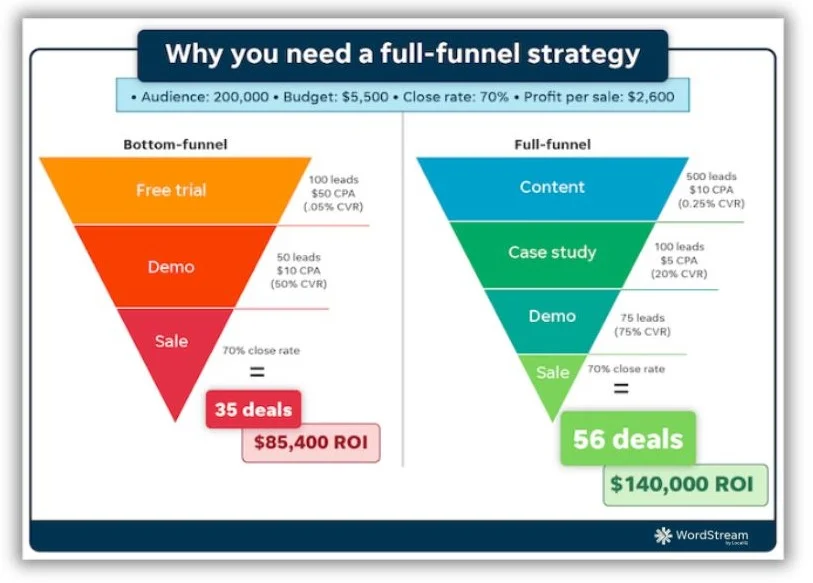

Identifies problem areas
As we just covered, a marketing funnel takes your one conversion action (becoming a customer) and breaks it into a series of smaller conversion steps. This way, you can establish benchmark conversion rates at each stage, which will allow you to monitor and adjust accordingly. For example, if you’re generating many good-quality leads but your demo conversion rate is lacking, you may want to revisit your bottom-funnel and sales enablement content.
What are the stages of the marketing funnel?
Now that you understand the marketing funnel and why it’s important, let’s review the different stages of the funnel and the best types of marketing strategies for each stage. Note that you can produce the same content formats at any stage of the funnel: blog posts, downloadable PDFs, website pages, ads, emails, and videos—what differs is the content topic.
Awareness stage
In the awareness stage of the marketing funnel (also called “top of funnel” or “TOF”), the consumer is aware of their pain points but not aware of your business. They may not even be aware of the product or service you offer. Your goal is to get them to understand the problem behind their symptoms, to learn that there are solutions, and to become aware that you exist.
What the consumer is doing: Searching online for information about their pain points. Their keyword intent is informational, so they’re searching things like “how to increase/decrease/improve X” and “why is X happening.”
Best strategies: Offer advice, be helpful, and educate people on the root problem in this content. Use blog posts, ebooks, PR, events, newsletters, guest blogging, social ads for guides, display ads, and more.
Example: My company, Hatch, is a text automation platform for contractors. But contractors in the awareness stage aren’t looking for or interested in this. They’re interested in their symptoms: leads not responding to their calls and sales representatives burning out. So, we have a blog post on reasons your leads aren’t responding.
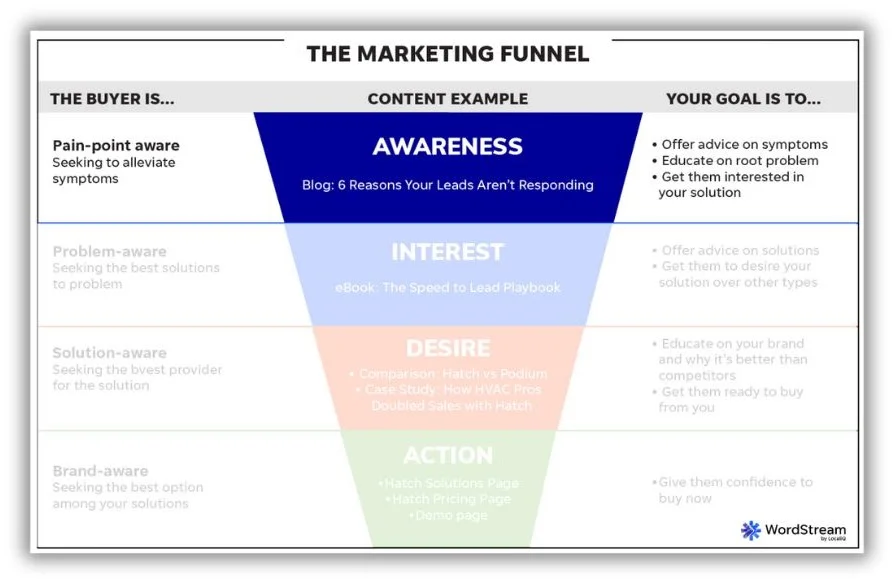

💡 Master the awareness stage with the free Definitive Guide to Brand Awareness: Top Strategies, Examples, & How to Measure Success.
Interest stage
In the interest stage of the marketing funnel, the customer is aware of the root problem behind their symptoms and that there are solutions to this problem—yours being one of them. Your goal is to get them interested in the solution you offer. This doesn’t necessarily mean your brand, just the type of solution.
What the consumer is doing: Searching for the best solutions to their problem. Their keyword intent is still informational, but the keywords are less about symptoms and more about solutions.
Best strategies: Provide education on the different solutions and offer content illustrating why yours is the best. Try free trials, product guides, explainer videos, buying guides, and search ads.
Example: Continuing with the Hatch example, the customer in this stage of the funnel is now aware that the problem behind the symptom of leads not responding is that they’re not reaching out fast enough. So, one of our middle-of-the-funnel pieces of content is this Speed to Lead Playbook. It’s got strategies for reaching out to leads faster, with automated texting (the solution Hatch provides) being one of those strategies.
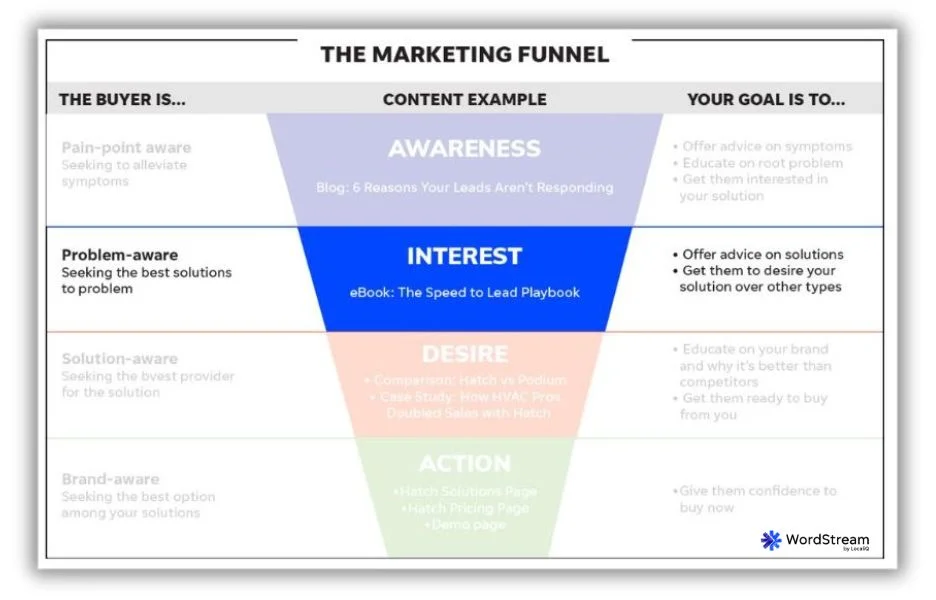

Desire stage
At the desire stage of the marketing funnel, the customer is aware of the problem and interested in your particular solution. Your goal is to convince them that your brand is the best provider of that solution.
What the consumer is doing: Evaluating your business, comparing it to competitors, asking friends about you, and reading reviews. Their keyword intent is commercial, which means they’re searching with terms like “reviews,” “compare,” “vs.,” “alternatives,” and “best.”
Best strategies: Show what makes you different from competitors. You can do this with one-pagers, comparison pages, case studies, testimonial pages, internal battle cards, and reviews. Also, focus on telling a compelling brand story that helps you to stand out.
Example: Still using our Hatch example, this post on Hatch vs. Podium examines how these two texting platforms differ and the types of businesses each one is best suited for.
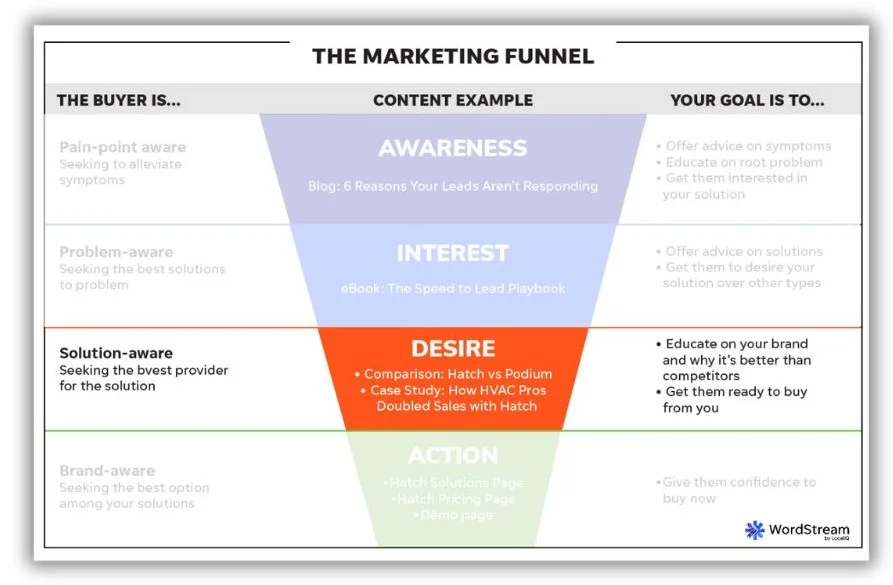

Action stage
In the action stage of the marketing funnel, the customer is now confident that you are the best solution for their problem. Your goal is to get them confident enough to buy now.
What the consumer is doing: Evaluating the specific offerings you provide, comparing packages, calculating prices, and doing final vetting. Their keyword intent is navigational (they’re returning to your site and review platforms) and transactional (they want to know how/where to buy from you).
Best strategies: Show why you are worth the price, why they should act now, and appeal to their emotions. Offer promotions, use compelling calls to action, and write persuasive copy that sells.
Example: The Hatch demo page or pricing page would be action-stage pieces of content.
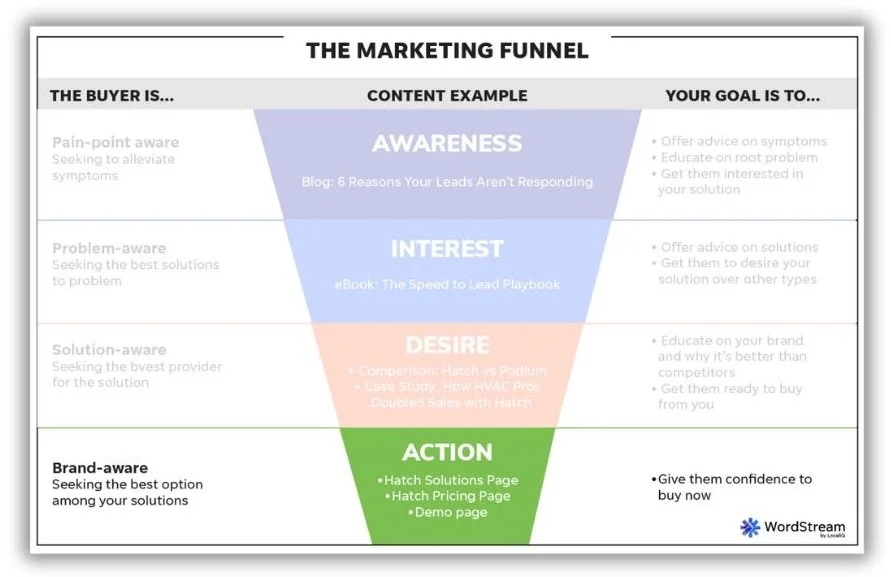

Maximize conversions with your marketing funnel
No matter what kind of business you have, it’s imperative that you understand what your marketing funnel looks like. Take the time to map yours out so you can increase conversion rates, create a better customer experience, and ultimately gain more customers. And if you identify problem areas, let us show you how we can help move prospects through each stage of your marketing funnel.
-
SEARCHENGINES7 days ago
Daily Search Forum Recap: April 29, 2024
-
SEARCHENGINES6 days ago
Daily Search Forum Recap: April 30, 2024
-

 MARKETING6 days ago
MARKETING6 days agoHow To Develop a Great Creative Brief and Get On-Target Content
-

 SEO7 days ago
SEO7 days agoGoogle’s John Mueller On Website Recovery After Core Updates
-

 WORDPRESS6 days ago
WORDPRESS6 days ago13 Best Fun WordPress Plugins You’re Missing Out On
-

 SEO5 days ago
SEO5 days agoWhy Big Companies Make Bad Content
-

 SEO5 days ago
SEO5 days agoHow To Drive Pipeline With A Silo-Free Strategy
-

 SEO6 days ago
SEO6 days agoOpenAI To Show Content & Links In Response To Queries
















You must be logged in to post a comment Login